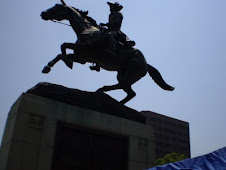Robert Scott, flying ace, RIP
Robert Scott, an American air ace of World War II, has died, according to the Telegraph.
Brigadier General Robert Scott, who has died aged 97, became an "ace" fighter pilot flying alongside RAF squadrons in Burma against the Japanese in 1942, an experience that he recorded in his classic wartime memoir God is my Co-Pilot; a film of the same name, starring Dennis Morgan as Scott, was released in 1945.
Scott was a flying instructor in California when the Japanese attacked Pearl Harbor in December 1941. He immediately volunteered for active duty but, at the age of 34, he was deemed too old.
Eventually, falsely claiming that he had flown a B-17 bomber, he managed to be assigned to a bomber force due to make a top-secret raid on Tokyo.
When the operation was cancelled he was in Karachi and was soon appointed operations officer for the Assam-Burma-China Ferry Command, flying supplies across the Himalayas to, among others, General Claire Chennault and his American Volunteer Group (AVG), better known as the "Flying Tigers", who operated in support of Nationalist Chinese forces.
Scott struck up a close friendship with Chennault, and persuaded him to lend him a P-40 Warhawk fighter, supposedly to protect the ferry route from attack. Scott operated over northern Burma and in the defence of Rangoon, the vital port for supplies to China.
In this fighter, which he called Old Exterminator, he carried out many ground-attack sorties against the advancing Japanese army and was soon in combat with enemy fighters: within a few weeks he had destroyed eight.
After the Japanese had occupied Burma, Scott and his pilots continued the fight in western China. The RAF air commander was full of praise for the AVG pilots, commenting: "Their gallantry in action won the admiration of both services."
When the Flying Tigers were disbanded in July 1942 and absorbed into the USAAF, Scott was appointed to command them with the 23rd Fighter Group of the China Air Task Force. By February 1943 he had been credited with destroying 13 aircraft - the authorities would not confirm a further nine probables because his aircraft did not carry a gun camera.
His successes made him one of the first US air "aces" of the war. The enemy placed a reward on Scott's head and he became known as the "one-man air force". After flying 388 combat missions, he returned to the United States....
After his service in China in 1942-43, Scott toured the United States to help sell war bonds before becoming the deputy for operations at the School of Applied Tactics at Orlando, Florida. He returned to China in 1944 to fly rocket-firing fighter-bombers in attacks on rail yards and re-supply lines.
The next year he went to Okinawa to fly similar operations against enemy shipping and remained there until the end of the war. Scott was awarded two Silver Stars, three DFCs and three Air Medals....
....
In October 1957 Scott retired, becoming a prolific writer on aviation subjects; his books included The Day I Owned the Sky and Flying Tiger: Chennault of China. He also lectured widely. In 1980, at the age of 72, he spent 93 days walking and riding a camel along the entire 2,000-mile length of the Great Wall of China.
In 1986 Scott returned to Georgia, ... and immediately became involved in the building and establishment of the Museum of Aviation at Robins Air Base, south of Atlanta. He continued to fly, and on his 88th birthday he flew in a F-15 Eagle fighter and a year later in the B-1 Lancer bomber.
Scott remained very active until the end of his life. In 1996, at the age of 88, he ran with the Olympic torch along a section of Georgia Highway 247 named in his honour.






No comments:
Post a Comment